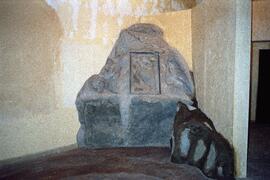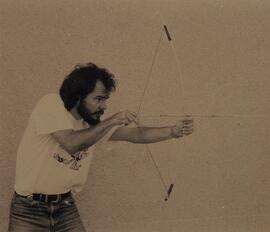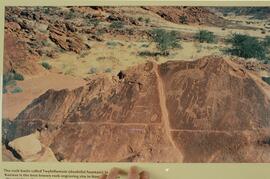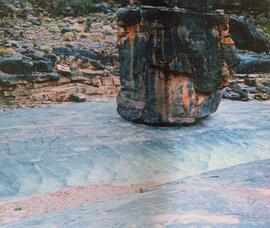Identity area
Reference code
NNM
Title
Naprstek Museum
Date(s)
Level of description
Collection
Extent and medium
Collection of artifacts
Context area
Name of creator
Biographical history
Repository
Archival history
Immediate source of acquisition or transfer
Content and structure area
Scope and content
Appraisal, destruction and scheduling
Accruals
System of arrangement
Conditions of access and use area
Conditions governing access
Conditions governing reproduction
Language of material
- English
Script of material
- Latin
Language and script notes
Physical characteristics and technical requirements
Naprstek Museum
Finding aids
Allied materials area
Existence and location of originals
Existence and location of copies
Related units of description
Notes area
Note
Background of the Recorder:The Náprstek Museum of Asian, African and American Cultures, operating within the National Museum in Prague, devotes systematic attention to the material and spiritual legacy of non-European civilizations. It strives to deal with their heritage in its full breadth and variety, to show the lasting share contributed by the individual peoples to the treasury of world cultures, and to capture all the essential aspects of both traditional cultures and contemporary trends in Asia, Africa, the Americas and Oceania. In keeping with these objectives, the museum is involved in collecting, preserving and restoring, keeping, analysing and publishing primary documentary material; apart from outstanding art works, it also deals with objects of everyday use, manuscripts, records of oral tradition, musical archives, photographic and graphic documentation, and archival documents at large.
In 1862, when promiment Prague cultural figure Vojta Náprstek prepared the museum´s conception, he endowed it with a truly extensive collection project whose aim was to provide the broadest possible documentation of handicraft and industrial production. His museum´s first exhibits were modern machines and equipment purchased by Náprstek in England, during his visit in 1862. Náprstek personally and his museum soon became centrepoints around which the Czech intellectual élite concentrated. The museum´s premises served for regular meetings of artists, scholars as well as explorers who would come to Náprstek´s home to get information, as well as to obtain understanding for their projects (Emil Holub, Enrique Stanko Vráz, Josef Ko?enský, Otokar Feistmantel, and many others). They shared with members of Náprstek´s circle of friends impressions from their voyages and expeditions, and they brought in their own collections. Thus came into existence the first systematic collections gathered in the field.
In the 1880s Náprstek erected a new three-storey building in the back section of his estate to house the museum, which he made permanently accessible to the public. After Náprstek´s death (1894), his widow, Josefa Náprstková, was assisted in the museum´s administration by a board consisting of Náprstek´s friends, which operated under the aegis of the city of Prague. In 1928, the board signed a contract, under whose terms the museum was handed over, effective from May 3, 1932, to the administration of the Land of Bohemia. By then it had assumed a new name, becoming the Náprstek Museum of General Ethnography. On January 1, 1943, the Náprstek Museum was incorporated by the then German administration into the National Museum. After World War II the Náprstek Museum of General Ethnography was confirmed as a part of the National Museum enjoying a special autonomous status. Finally, in 1962, on the occasion of the centenary of its foundation, the museum´s, thus far predominant, accent on ethnographic approaches was extended to embrace the fine arts, applied art, archaeology and numismatics, and the change of conception was projected into its new name: the Náprstek Museum of Asian, African and American Cultures.
After World War II, came a new period of expanding the collections: since then the museum has acquired about two-thirds of its listed items, a trend which has been accompanied by a significant upgrading of the collection´s composition, typological structure and documentation.
In 1862, when promiment Prague cultural figure Vojta Náprstek prepared the museum´s conception, he endowed it with a truly extensive collection project whose aim was to provide the broadest possible documentation of handicraft and industrial production. His museum´s first exhibits were modern machines and equipment purchased by Náprstek in England, during his visit in 1862. Náprstek personally and his museum soon became centrepoints around which the Czech intellectual élite concentrated. The museum´s premises served for regular meetings of artists, scholars as well as explorers who would come to Náprstek´s home to get information, as well as to obtain understanding for their projects (Emil Holub, Enrique Stanko Vráz, Josef Ko?enský, Otokar Feistmantel, and many others). They shared with members of Náprstek´s circle of friends impressions from their voyages and expeditions, and they brought in their own collections. Thus came into existence the first systematic collections gathered in the field.
In the 1880s Náprstek erected a new three-storey building in the back section of his estate to house the museum, which he made permanently accessible to the public. After Náprstek´s death (1894), his widow, Josefa Náprstková, was assisted in the museum´s administration by a board consisting of Náprstek´s friends, which operated under the aegis of the city of Prague. In 1928, the board signed a contract, under whose terms the museum was handed over, effective from May 3, 1932, to the administration of the Land of Bohemia. By then it had assumed a new name, becoming the Náprstek Museum of General Ethnography. On January 1, 1943, the Náprstek Museum was incorporated by the then German administration into the National Museum. After World War II the Náprstek Museum of General Ethnography was confirmed as a part of the National Museum enjoying a special autonomous status. Finally, in 1962, on the occasion of the centenary of its foundation, the museum´s, thus far predominant, accent on ethnographic approaches was extended to embrace the fine arts, applied art, archaeology and numismatics, and the change of conception was projected into its new name: the Náprstek Museum of Asian, African and American Cultures.
After World War II, came a new period of expanding the collections: since then the museum has acquired about two-thirds of its listed items, a trend which has been accompanied by a significant upgrading of the collection´s composition, typological structure and documentation.
Note
Collection obtained from: Naprstek Museum
Note
Provenance: Naprstek Museum
Note
Collection owner image: NNM.jpg
Alternative identifier(s)
Access points
Subject access points
Place access points
Name access points
Genre access points
Description control area
Description identifier
Institution identifier
Rules and/or conventions used
Status
Level of detail
Partial













